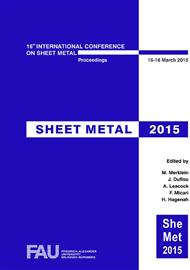p.243
p.251
p.259
p.267
p.275
p.283
p.291
p.301
p.309
Influence of Surface Modifications on Friction, Using High-Feed Milling and Wear Resistant PVD-Coating for Sheet-Metal Forming Tools
Abstract:
Increasing technological requirements, as well as the demand for an efficient production demands high performance materials and enhanced manufacturing processes. The development of a new manufacturing process, sheet-bulk metal forming (SBMF), is one approach to produce lightweight forming parts with an increased number of functional properties while, at the same time, combining the advantages of sheet and bulk metal forming. For SBMF processes, the specific adjustment of the friction between tool and workpiece for a specifically designed material flow, which is called tailored friction, is of great importance. The reduction of friction is essential in order to ensure a homogeneous forming zone. However, a higher friction can be used to control the material flow to increase the local thickness of the work piece for additional functional integration. This paper shows the development of surface structures for SBMF tools by means of high-feed milling. Process parameters like the tilt angle or the feed are varied to influence the surface parameters of the structures, which results in different tribological properties of the forming tool. The structured surfaces are subsequently coated with a wear resistant CrAlN coating, processed by a magnetron-sputtering process (PVD) to enhance the lifetime and performance of the forming tool. Finally, a ring compressing test is used to investigate the tribological behavior of the coated structures.
Info:
Periodical:
Pages:
275-282
Citation:
Online since:
March 2015
Keywords:
Price:
Сopyright:
© 2015 Trans Tech Publications Ltd. All Rights Reserved
Share:
Citation:


